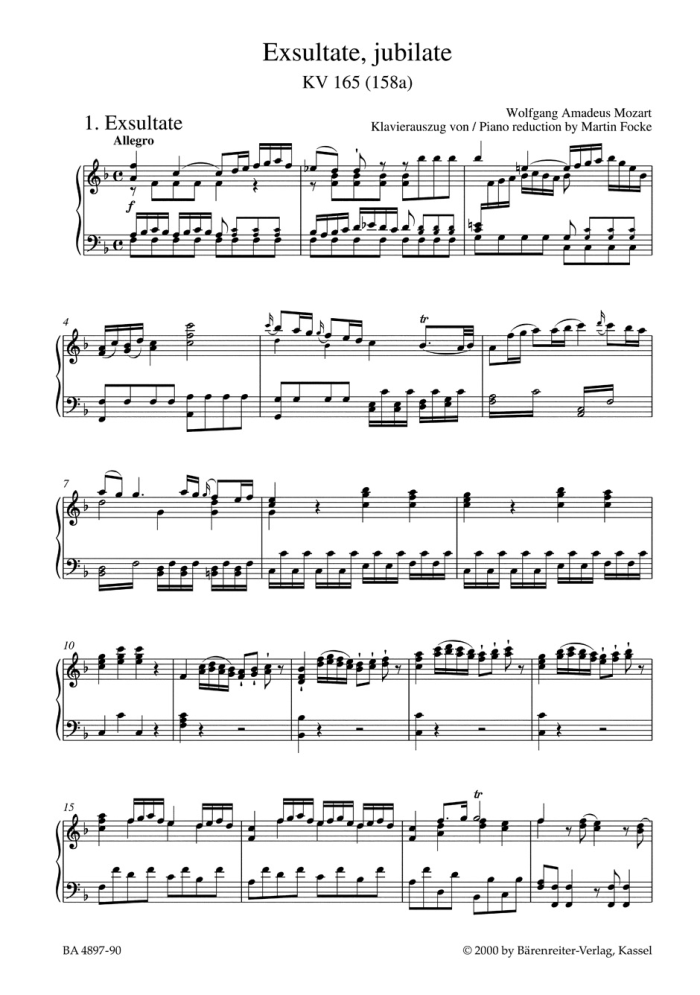
Happy Present Meet
Mozart Exsultate, Jubilate K.165 (158a) Voice and Piano (Vocal Score)
Sacred Vocal Works
with additional material from the Salzburg version
Revised edition
Duration (approx.): 00:17:00
“In Italy nowadays this term (motet) is applied to a Latin sacred solo cantata consisting of two arias and two recitatives, concluding with an Hallelujah, and sung during the Mass following the Credo, generally by one of the best singers.” One composition matching this description is the solo motet Exsultate, jubilate, K. 165/158a, which Mozart wrote in Milan early in 1773 following the highly successful performance of his opera Lucio Silla.
In 1978, when the music manuscripts in Bavaria were being sorted and cataloged in a project sponsored by the Deutsche Forschungsgemeinschaft, a set of manuscript parts for a previously unknown second version was discovered in the town parish church of St. Jakob in Wasserburg am Inn. The music and text of the concluding Alleluja movement were written out by the Salzburg court bassoonist and copyist Joseph Richard Estlinger (c. 1720–1791), who frequently worked for Mozart and his father.
The vocal text of this Salzburg manuscript departs from that of the Milan version in the first aria and in the recitative. It was entered in a different hand. The Salzburg version of the text is clearly related to the feast of the Holy Trinity. There is much evidence that this version was sung for the first time in the Dreifaltigkeitskirche on 30 May 1779 (i. e. Trinity Sunday) by the Salzburg male soprano Francesco Ceccarelli during a service mentioned by Nannerl Mozart. On that day Leopold and Wolfgang Mozart, together with Ceccarelli, were invited to the church’s vicarage at midday. The additional text underlaying of the first aria enabled the solo motet to be employed for the Christmas service as well.
"오늘날 이탈리아에서 이 용어(모테트)는 두 개의 아리아와 두 개의 레치타티보로 구성된 라틴어 성스러운 독주 칸타타를 지칭하며, 할렐루야로 마무리됩니다. 이 칸타타는 크레도(신조)에 이은 미사에서 일반적으로 최고의 성악가 중 한 명이 부릅니다." 이러한 설명과 일치하는 작품 중 하나는 모차르트가 1773년 초 밀라노에서 오페라 루치오 실라(Lucio Silla)의 대성공 이후 작곡한 독주 모테트 〈환희에 넘쳐, 기뻐하라, 기뻐하다〉(K. 165/158a)입니다.
1978년, 독일 연구 협회(Deutsche Forschungsgemeinschaft)의 후원으로 바이에른의 악보를 정리하고 목록화하던 중, 바서부르크암인(Wasserburg am Inn)에 있는 성 야콥(St. Jakob) 교구 교회에서 이전에는 알려지지 않았던 두 번째 버전의 악보 악보 일부가 발견되었습니다. 마지막 알렐루야 악장의 음악과 가사는 잘츠부르크 궁정 바순 연주자이자 필경사였던 요제프 리하르트 에스틀링거(1720년경~1791년)가 작곡했는데, 그는 모차르트와 그의 아버지 밑에서 자주 일했습니다.
이 잘츠부르크 악보의 성악 가사는 첫 번째 아리아와 레치타티보에서 밀라노 버전과 다릅니다. 다른 필체로 작성되었습니다. 잘츠부르크 버전은 성삼위일체 축일과 분명히 관련이 있습니다. 이 버전이 1779년 5월 30일(즉, 성삼위일체 주일) 드라이팔티히카이츠키르헤에서 난네를 모차르트가 언급한 예배에서 잘츠부르크 남성 소프라노 프란체스코 체카렐리에 의해 처음 불렸다는 많은 증거가 있습니다. 그날 레오폴트와 볼프강 모차르트는 체카렐리와 함께 정오에 교회의 사제관으로 초대되었습니다. 첫 번째 아리아에 추가된 텍스트 덕분에 솔로 모테트를 크리스마스 예배에도 사용할 수 있었습니다.
편곡자 Focke, Martin
작곡가 Mozart, Wolfgang Amadeus(1756-1791)
에디터 Federhofer, Hellmut
Munster, Robert

Haydn Die Schopfung (The Creation) Hob.XXI:2 (Vocal Score) (E/G)
Faure Pie Jesu (Blessed Jesus) from Requiem in D minor, Op.48 - High
[특가상품] Schubert Lieder Vol.9 with texts by Rellstab,Heine and Seidl (High)
Piazzolla Ave Maria for Voice and Piano
Lehar Meine Lippen sie Kussen so heiss form Giuditta for Voice and Piano
[특가상품] Puccini Il Trittico for Vocal Score (Hard Cover) (I/E)
[특가상품] Puccini Il Trittico for Full Score
Mozart Complete Songs for High Voice and Piano (German) - Urtext